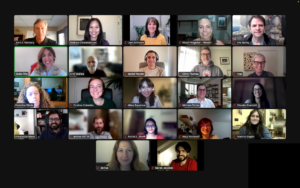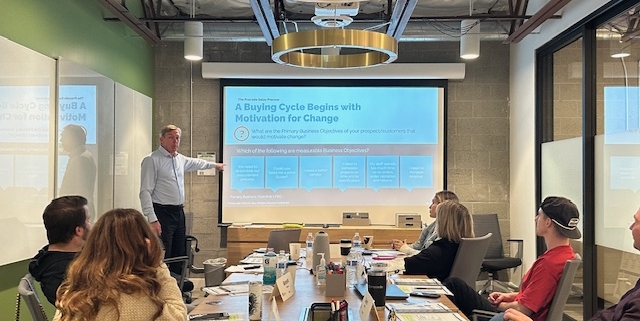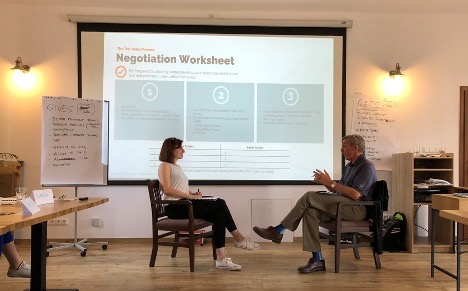You spent a lot of time building, delivering and coaching your commercial strategy for this year. And soon you’ll find out the results. To meet and exceed on a regular basis requires some fundamental execution. Click above to learn more.
One of the hardest parts of sales is keeping the pipeline filled with qualified opportunities. Nurturing leads is something salespeople put off. Akin to delaying the home maintenance project you perceive as time-consuming or the medical check-up that makes you uneasy – procrastination is a creeper But avoiding necessary actions can make things harder over the long term.
We know the importance of sustaining the pipeline and nurturing leads so why do we drag our feet? I’ll explain some reasons why as well as tell you how to prevent procrastination from taking root.”
So, what’s hanging us up?
- Time Constraints: Sales reps often face tight schedules and multiple priorities. Nurturing leads requires time and effort, which can lead to procrastination when other urgent tasks take precedence.
- Lack of Resources: Limited resources, such as manpower or tools for automation, can make lead generation seem like a daunting task.
- Focus on Immediate Wins: Low-hanging fruit. Some may prioritize pursuing new leads and immediate sales rather than investing time in nurturing existing leads, especially if they are focused on meeting short-term targets.
- Unclear Strategy: Without a well-defined strategy, sales teams may struggle to prioritize and execute consistent actions, leading to procrastination.
Being mindful of your circumstances and some of the classic reasons why we procrastinate can help reduce its occurrence. Here are some other ways to bury the tendency and continuously fill (not kill) the pipeline.
- Evaluate Current Customers: It is not uncommon for 60-70 % of new revenue to be generated from an existing customer base. These prospects are more likely to close in a timely, predictable fashion, and forecasting their revenue is typically more accurate.
- Assess the Lead’s Value: Whether a lead is given to you or organically generated, the most qualified leads are those with a personal connection. We are interconnected like no other time in history – personally and professionally. A quick LinkedIn search can reveal if you know someone within the company you are targeting. A cold lead instantly turns warm with an introduction from a mutual acquaintance.
- Weigh Progress with a Milestone: The velocity of water through a pipe depends on pressure. Likewise, it’s advantageous for salespeople to have some pressure – or triggers – to determine the pace of a deal from contact to close. This is especially true immediately following an initial customer conversation. Did the customer share any goals? If yes, spend more time pursuing that. A great forecasting tool is a Deal Map. This document identifies by date and responsibility a map of the deal. Buyer and seller agree to the terms and proposed timeline. When both parties are working off the same document, forecasting probability and close date are easy to determine.
Regularly evaluating and refining your approach will contribute to a more resilient and effective sales pipeline management strategy – leading to more confidence and less procrastination. As William Butler Yeats, one of the greatest poets of the 20th century, said, “Do not wait to strike till the iron is hot, but make it hot by striking.”
Trust is a crucial aspect of business and relationships. Developing trust over the duration of a customer relationship takes attention and focus. Creating a good first impression can go a long way in establishing trust in business relationships. The initial encounter sets the tone for future interactions and can significantly impact how others perceive you or your company.
I’ve shared how the concept of trust was uniquely presented to me as I went through airport security on an international trip. After responding to the standard questions, the security agent asked a final question, “Should I trust you?” I answered in the affirmative, of course, but the unconventional question got me thinking!
Reflecting on the experience – which was used to gauge my response under pressure and assess my overall demeanor – I gained real insight into how trust is perceived and established. In business and personal relationships, trust develops through a combination of communication, consistency and demonstrated reliability. Verbal and non-verbal cues also play a significant role in establishing trust.
When meeting with a prospect for the first time, how do you establish trust? This is not the same type of trust you have with a family member or friend. It’s the trust that allows someone to have a candid conversation about their business issues.
Plenty is written about what not to do, such as being pushy, talking too much or just falling into stereotypical selling behavior. But in that critical window of time (which can be as short as a minute) how do you make a connection that allows the prospect to feel comfortable sharing information with you? How do you show that you genuinely care about understanding their business situation?
Here are three actionable steps to help establish trust during your initial interactions.
- Be prepared with questions about the prospect’s organization and needs, not statements or brochures about your product, service or organization.
- Allow the prospect to set the pace of the meeting. Help the prospect discover their needs by listening to what they say. A few well-constructed questions will help the prospect come to their own conclusion. And only offer suggestions for items to review after they have expressed their priorities.
- Be sincere. Being sincere means doing what you say you are going to do. The first way to establish sincerity is a prompt, written follow-up after that initial meeting that captures the important components for the prospect and their organization.
You can shape the trajectory of a long-term customer relationship by establishing trust early on. While some think trust takes years to cultivate and develop, the agent at the airport thought it could take one second, a reaction to a question. One thing is certain; establishing trust is a central component of all healthy relationships. Successfully lay the foundation and watch a lasting and fruitful customer relationship unfold.
Have you ever spent several thousand dollars (and then some) on training only to see no change or short-term boosts at best? If your sales training is striking out, it’s probably due to a lack of prep and follow-up. There are ways to achieve long-term positive changes through training but you’ve got to know what you’re signing up for and consider some clear-cut strategies.
For starters, different types of training accomplish different goals. Over the years we’ve been hired by clients for one-hour kick-off motivational keynotes, three-day intensive sales process training and everything in between. We’ve learned a few things along the way including – sales training conducted as an “event” simply doesn’t work.
If your goal is to transform your organization so that it’s achieving goals like increasing sales or increasing profit margin, the training itself is only 10% of the overall process. To make your training investment stick, consider the following before you spend valuable dollars.
You Need an Implementation Plan. Start your transformation with the end in mind. What metrics will be used to measure the success of the salespeople, manager and related team member(s)? Will leadership hold them accountable for achieving these goals? For example, to achieve 10% growth in revenue you’ve calculated that each salesperson needs to meet with one additional qualified prospect per day. The skill being developed is new business development. How will you hold each person accountable for that number? The measure of success could be an email the salesperson sends to the customer that summarizes their meeting. This is an auditable measure that a manager and a manager’s manager can use. The email not only provides quantitative measurement, but the leaders, and even the CEO, can review the email and see the quality of customer interactions. How well was the new skill captured in the follow-up e-mail? Does this contact meet the defined metric of adding one new qualified prospect per day?
Have a Strategy to Reinforce and Coach Learned Skills.
Sales skills that are enhanced or gained in a training session are 80% forgotten after the first 30 days. Why? When not practiced or measured with a 3rd party, there’s often little to no change in behavior. The formula for reinforcement is: a) apply the learned skill b) share results with the coach and then c) reinforce the behavior. For coaching, first get attendees to apply new skills in the field. This could be verbal or written sales skills – but only introduce one skill at a time. Then it’s time to coach. Ask specific questions about the desired outcome. For the example above, did the salesperson meet (or converse) with one new, qualified prospect a day? Frame questions that help them understand what went well and where correction needs to happen. Next, ask them how they can improve their results. Effective coaches help people find their own answers. Finally, ask what would happen if the next time they tried … and then insert a specific recommendation. Reviewing a video of someone good at executing a skill is a way to fine-tune a new sales method. Rehearsing a future conversation with a recording is also a good practice.
When changes are reinforced, salespeople will remember how inspired and motivated they were at training. And with effective measuring, they’ll know these skills and behaviors will be recognized.
When I’m retained by clients to help their sales team, the first thing I do is to ask to interview their top performers. My purpose is to decode their selling DNA and identify the markers that make them successful.
Invariably, effective salespeople sell value, not solutions or services. They recognize that it’s the ‘why’ that resonates with buyers – the business value. Equally revealing is illustrating how today’s problems impact the overall bottom line. But selling value and the total cost of problems facing a customer is where many sales teams run into trouble.
Pinpointing and helping customers articulate these positions may not come naturally but it’s a necessary practice if you want to meet or beat your goals. Top performers use the following three tactics to draw out the answers to business value and the cost of challenges.
- Get to the cost of today’s problem. Buyers face a number of problems and challenges. Great salespeople help buyers define – in totality – all of the costs these problems bring. While costs may be non-monetary, such as frustration or low morale, the numbers that hit the bottom line are those that are heard by every person involved in the buying decision. Great sellers shape and frame conversations around the costs of the buyer’s problems. This is especially important if the solution’s value comes with a higher price tag. Early conversations around costs will help sell more and ensure that the necessary margins are hit in the end.
- Tell stories. Stories help buyers discover for themselves the problems that they are facing and the solutions they need. High achievers have several stories at the ready that they can tailor and share based on the buyer’s situation or desired outcome. When the conversation lulls and the buyer is unable to explain their problem, share a story! Start by framing who the experience is about. Then identify the problem, turning point and resolution. Buyers who hear successes and failures of industry peers become more willing to share details about themselves and have an easier time finding their voice. Stories not only get to problems, they also help describe how others use and derive business value from your products. Stories have purpose and great salespeople use them again and again.
- Summarize conversations in writing. This is a tactic that all sellers tell me they do, but few do it well. I sell my services to many companies in different industries. I constantly refer to follow-up emails I’ve written after conversations. The emails sum up problems a client is facing and the associated costs, the solutions we discussed and their value, and of course, proposed next steps. These emails help the customer and I keep the focus on the problems we are trying to solve. Top performers don’t rely on memory. They simplify, write the plan down, share it with the customer and allow the customer to give feedback.
If you want to sell the business value your products bring, incorporate these techniques and the process will be habit in no time.
Many new sales managers think they are good at managing salespeople because they excel at selling. While selling may have come naturally to them, it’s not innate for everyone. And now, a frontline manager, it’s their job to recognize performance barriers and empower their reps.
But a promoted salesperson often has a hard time letting go of the adrenaline rush that comes from being in the action and chasing big deals. He or she may end up taking charge of a customer relationship and finish the sale, undermining a rep’s motivation and confidence. Equally problematic are first-line managers who expect everyone to produce the same exceptional sales results they delivered – but without providing any coaching or constructive feedback.
A recent report from Gartner found that the average sales manager spends only 21% of their time coaching – it simply gets pushed aside. Turnover becomes high in situations where businesses are not producing skilled reps who have learned to achieve revenue growth on their own. Progressive organizations, however, recognize that teaching managers how to deliver personalized coaching and training – which ultimately produces high-achieving team members – has a greater impact on overall sales performance than just training the sales reps alone.
We were recently hired by such an organization. Their new sales rep team was being managed by their superstar salesman – who was also new to the role. With his compensation tied to the team’s revenue numbers, it was understandable that he wanted to “make it happen.” He was involved in every account, micromanaging the reps, constantly asking for updates, solving problems, and often stepping in to save the sale as quarter-end approached. While the compensation was good for all of them, the manager was exhausted and the reps felt unappreciated, unmotivated, unfulfilled and eventually, unable to work under such conditions.
Major change was needed and teaching their first-line managers how to coach their direct reports on sales skills was priority one. We helped the organization link its sales process to practical, teachable selling skills, setting up a structure for skills coaching based on individual sales reps’ needs. The change came slowly but steadily. Because the managers were trained around conversations on current account strategies and within the parameters of their busy schedules, they developed muscle memory around their new coaching skills through practice with their teams.
Results followed, with an 11% increase in revenue from existing customers, a noticeable increase in the new opportunity pipeline, and a happier, more productive team. So remember, if you’re looking to drive sales productivity, make sure coaching is a part of your process.
In the current business landscape, establishing the value of your product or service is more crucial than ever. If you can’t clearly communicate how your offering can boost revenue or reduce costs, it becomes challenging for potential customers to see why they should choose you over your competitors. According to a study by Forrester Research, the primary obstacle to achieving your sales targets is the inability to effectively convey a value proposition.
Here are some of the top inhibitors to meeting sales quotas:
- Insufficient leads: 13.3%
- Poor sales skills: 16%
- Too many products to know: 21.4%
- Information gap: 24.3%
- Inability to communicate a value message: 26%
“Value proposition” is a term that gained popularity in the 90s, and regardless of whether it’s considered a buzzword or not, establishing your product or service’s value without overwhelming potential customers with a barrage of features and benefits remains essential. So, how can you achieve this?
- Understand Your Customers: Begin by studying your customers thoroughly. Dive into their market, understand what they sell, assess the competitive landscape, consider the size of their organization, and identify the key decision-makers involved in their processes. Conduct informational interviews within your network, seeking insights from industry insiders who have experience with your ideal customer. Lastly, engage directly with your customers and prospects. Learn about their goals, how they measure success, and understand their pain points. Armed with this research, you’ll be well-equipped to position yourself effectively to resonate with your target audience.
- Demonstrate Value: Utilize the knowledge you’ve gained about your customers to craft a message that highlights the value of your product from their perspective. Explain how your product can alleviate their pain points and help them achieve their daily, weekly, monthly, and quarterly objectives. Some examples include:
- “Imagine a day without the stress of x, y, and z. With the time you save, you’ll be able to accomplish twice as much of what you need to do.”
- “Whether it’s daily, weekly, or yearly, we understand that goals are always top of mind. Let (product X) help reduce the time it takes to meet those goals by taking advantage of x and y capabilities.”
- Position and Differentiate: Identify what sets you apart from your competitors. Is it your exceptional customer service, an extensive range of capabilities, or competitive pricing? Whatever it may be, ensure that this differentiation is consistently emphasized across all your sales and marketing channels. Align your messaging on your website with your social media channels, marketing materials, and the language used by your sales representatives. This might sound straightforward, but regrettably, many organizations overlook this crucial step.
By understanding your customer, effectively demonstrating value, and clearly positioning your unique offerings, you can streamline the sales process and avoid falling into the 26% of businesses that struggle to communicate their product’s value consistently and persuasively.
Immediately following Sales Process Workshops in Spain and France, John is interviewed by Cristina Lourenco from Acolad on how customized, focused and actionable sales training turns into revenue. Have a listen to what happens before, during and especially AFTER the training that gets results.
In the dynamic realm of business-to-business (B2B) sales, effective sales coaching is paramount to achieving outstanding results. Sales managers play a critical role in guiding and developing their teams, helping them excel in the art of persuasion and relationship-building. In this blog post, we will explore the significance of sales coaching in the B2B space and outline key strategies to help sales managers elevate their coaching game.
- Understanding the Role of Sales Coaching: Sales coaching goes beyond mere instruction or oversight. It is a proactive process that empowers sales managers to foster growth, optimize performance, and drive revenue generation within their teams. By identifying individual strengths, areas for improvement, and aligning them with organizational objectives, sales coaching plays a pivotal role in cultivating a high-performing sales force.
- Developing a Coaching Mindset: Successful sales coaching begins with cultivating a coaching mindset within sales managers. It involves adopting a collaborative approach rather than a directive one. Encouraging open communication, active listening, and empathy can establish a trusting relationship between managers and their sales representatives, creating an environment conducive to growth and learning.
- Setting Clear Goals and Expectations: Clarity is key when it comes to sales coaching. Sales managers must establish clear goals and expectations for their team members, ensuring everyone is aligned and working towards a shared vision. Setting measurable objectives, such as specific revenue targets, customer acquisition rates, or conversion rates, provides a framework for progress evaluation and motivates individuals to strive for excellence.
- Personalized Coaching Plans: Every sales representative possesses unique strengths and areas for improvement. Effective sales coaching requires managers to create personalized coaching plans tailored to each team member’s needs. Conducting regular assessments, such as skill gap analysis or performance evaluations, helps identify specific areas that require attention. By addressing these gaps through targeted training and mentorship, managers can unlock the potential of their sales team members.
- Ongoing Skill Development: Sales coaching is an ongoing process that should foster continuous skill development. Encourage self-reflection and self-assessment among sales representatives, allowing them to identify their own strengths and areas for improvement. Providing access to resources, training programs, and industry insights can further enhance their knowledge and expertise, equipping them with the tools to adapt to evolving market dynamics.
- Effective Communication and Feedback: Communication lies at the core of successful sales coaching. Regular feedback sessions, both individual and collective, allow managers to provide constructive criticism, highlight achievements, and offer guidance. By fostering a culture of open dialogue, sales managers can create an environment where sales representatives feel supported, empowered, and motivated to achieve their goals.
- Lead by Example: Sales managers must lead by example, demonstrating the qualities and behaviors they expect from their team. By exhibiting strong sales skills, effective communication, and a passion for continuous improvement, managers inspire their team members to follow suit. Leading by example builds credibility and trust, fostering a positive coaching environment that drives excellence.
Conclusion: In the competitive world of B2B sales, sales coaching is the catalyst that propels sales teams to surpass their targets. By embracing a coaching mindset, setting clear goals, and developing personalized coaching plans, sales managers can optimize their team’s performance and foster a culture of continuous improvement. Through effective communication, ongoing skill development, and leading by example, sales managers can unlock the full potential of their sales force and achieve remarkable results in the B2B sales arena.


There’s no doubt that sales training is an investment; but, when done right, it’s one of the smartest investments your company can make. Small improvements in selling techniques can make a huge impact on revenue. What would it mean to your sales results if your average reps were producing as well as your top performers?
We have 17 years of experience training sales teams, which means equipping them with the skills and tools they need to achieve sales goals. We are different from other training organizations because we don’t teach a one-size-fits-all course. Our curriculum is customized to your unique sales process and selling environment. Your reps will leave our course having learned and practiced the techniques they need to successfully engage with prospective customers to drive revenue.
We provide both in-person live sales training along with virtual sessions. While we love to engage in person with your teams, if you do opt for an online training experience, you can rely on our fine-tuned virtual event platform that allows you to maximize learning opportunities through group break out discussions, private and public chat features and a one-on-one coaching.
Whether you choose to hold your sales training in-person or virtually, take advantage of our Online Learning Portal which has helped hundreds of our customers’ salespeople reinforce what the sales skills they acquire in our workshops.







